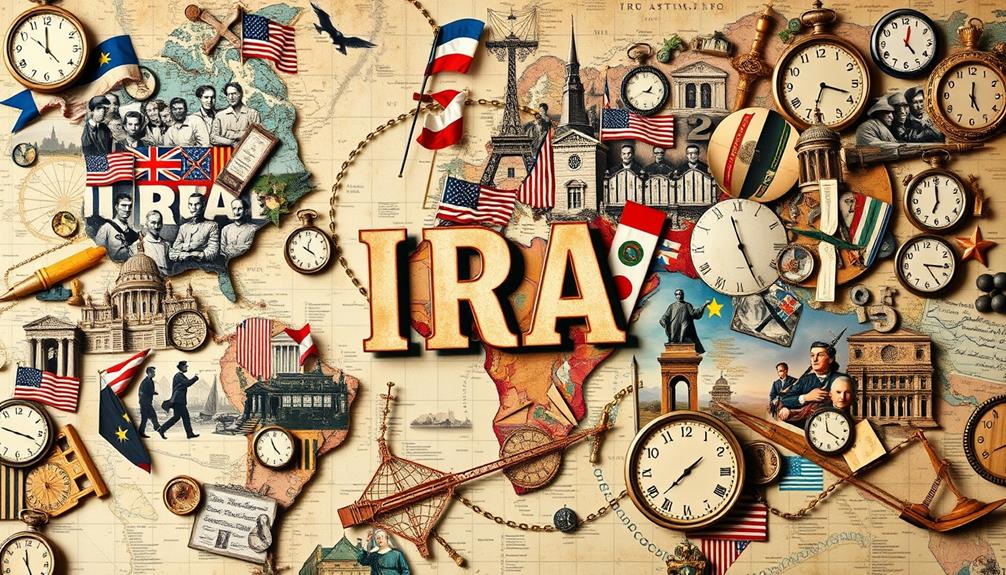You have the potential to access significant wealth-building opportunities by investing in startups and private equity through a self-directed IRA (SDIRA). This method provides you with greater control over your investments and offers tax-deferred growth similar to traditional IRAs. There is a high return potential, as successful startups can generate impressive gains over time. It is crucial to navigate IRS regulations and avoid prohibited transactions in order to maintain tax advantages. With the appropriate guidance and thorough research, you can enhance your portfolio’s diversification and unlock an exciting financial future. There is plenty more to discover about how to maximize your IRA in this manner.
Key Takeaways
- Self-Directed IRAs (SDIRAs) allow investments in startups and private equity, providing greater control and tax-deferred growth compared to standard IRAs.
- Investing in startups offers high return potential, with historical private equity returns averaging 14% to 16% over two decades.
- Diversifying into startups can enhance portfolio performance and reduce overall risk within retirement plans.
- Compliance with IRS regulations is crucial for maintaining tax advantages and avoiding penalties related to prohibited transactions.
- Professional advice is essential for navigating risks, understanding tax implications, and accessing quality investment opportunities in startups and private equity.
Understanding Self-Directed IRAs

A Self-Directed IRA (SDIRA) can be a powerful tool for diversifying your retirement portfolio. Unlike standard IRAs, an SDIRA allows you to invest in alternative assets like private equity and startups, giving you greater control over your investment process.
With an SDIRA, you're not limited to traditional investments like stocks and bonds; instead, you can choose opportunities that align with your financial goals and risk tolerance. This flexibility can enhance your investment strategy by allowing for unique investment opportunities that may yield high returns.
You'll need a custodian to manage your SDIRA, ensuring compliance with IRS regulations while facilitating your transactions. It's vital to understand that while the IRS permits a wide range of investments, certain transactions—like self-dealing or investing in collectibles—are prohibited. This makes it essential to stay informed about the rules governing your SDIRA.
One of the biggest draws of a self-directed IRA is the tax advantages it offers. Similar to traditional IRAs, SDIRAs allow for tax-deferred growth, meaning you won't pay taxes on your earnings until you withdraw them.
If you're considering this route, consulting a financial advisor can help you navigate the complexities and maximize your investment potential.
Advantages of Investing in Startups

Investing in startups can open the door to high return potential, especially as some companies skyrocket in value.
With the growing demand for transparency in private equity and an emphasis on sustainability and responsible investing, it also allows you to diversify your portfolio, balancing out traditional investments with innovative ventures.
With a long-term growth horizon, these opportunities can greatly enhance your retirement strategy.
High Return Potential
When you consider the potential of investing in startups, the allure of high returns becomes evident. By using a self-directed IRA, you can tap into a world where early-stage companies can skyrocket in value. This approach aligns with the trend of data-driven strategies that yield measurable results in investment performance.
Here are three reasons why startup investing offers high return potential:
- Exponential Growth: Companies like Uber and Airbnb transformed from small startups into billion-dollar enterprises in just a few years.
- Strong Historical Performance: Private equity investments have shown average annual returns of 10% to 15%, outperforming many public market alternatives.
- Unique Opportunities: The U.S. startup ecosystem is valued at over $500 billion annually, presenting savvy investors with unique chances to capitalize on innovative ventures.
Diversification Opportunities
Diversifying your investment portfolio with startups can greatly enhance your financial strategy. By utilizing self-directed IRAs, you can introduce non-traditional assets into your retirement plan, which can considerably reduce your overall risk.
Startups often offer unique investment opportunities that aren't typically found in public markets, much like the advantages of Gold IRAs that provide a hedge against inflation. This allows you to tap into innovative sectors and emerging trends, providing a fresh avenue for diversification.
Allocating a portion of your IRA to startups opens the door to a vast pool of funding opportunities. Thousands of startups actively seek capital for growth and development, giving you the chance to invest in promising ventures.
Furthermore, the potential for high returns in startup investments can greatly boost the overall performance of your IRA, especially if a startup goes public or is acquired.
Diversifying into startup investments aligns well with a long-term investment strategy, as these ventures usually require time to mature. This complements the retirement planning horizon of IRA investors, allowing you to balance risk and reward effectively.
Embracing startup investments not only enhances your portfolio but also positions you strategically for future financial success.
Long-Term Growth Horizon
Allocating funds in your IRA to startups not only opens up unique investment avenues but also capitalizes on the long-term growth potential these companies can offer.
By embracing a long-term growth horizon, you set yourself up for substantial returns when investing in private equity. Many investors are also turning to Gold IRAs to diversify their portfolios and hedge against market volatility.
Consider these key advantages:
- Maturity Timeline: Startups typically take 5 to 10 years to grow, fitting perfectly within your retirement planning timeline.
- Compounding Returns: Your IRA can benefit from compounding returns, as early-stage companies often realize significant growth over time.
- Substantial Upside: Successful startups can return 3-10 times your initial investment, showcasing the untapped potential of long-term commitments.
Investing in startups through your IRA allows for tax-free growth and withdrawals, amplifying your long-term wealth accumulation strategy.
Historically, private equity investments have outperformed public markets, with average annual returns of 14% to 16% over the past two decades.
By focusing on long-term growth, you're not just investing; you're strategically building a future that aligns with your retirement goals.
Embrace the possibilities that come with a long-term mindset and watch your IRA investments flourish.
Navigating Regulatory Requirements

When you invest in startups through your self-directed IRA, you need to understand the IRS regulations that apply.
Protect your savings by avoiding prohibited transactions, which can lead to serious penalties.
It's crucial to know what's allowed and what isn't. Staying compliant with reporting requirements and working with a knowledgeable custodian will help you navigate these complexities effectively.
IRS Regulations Overview
Understanding IRS regulations is essential for anyone considering investments in startups through an IRA. Familiarizing yourself with these rules can help you avoid costly mistakes and guarantee your investments are compliant. Here are three key points to keep in mind:
1. Self-Directed IRAs: You can invest in startups using self-directed IRAs, but you must adhere to IRS guidelines. These accounts allow you more flexibility, as they can accommodate various investment options including best ways to earn money online.
However, you should know the boundaries.
2. Prohibited Transactions: Be aware that certain transactions are off-limits, like self-dealing or investing in collectibles. Engaging in these activities can jeopardize your IRA's tax-advantaged status.
3. Compliance Requirements: Confirm you meet annual contribution limits—$6,500 for those under 50 and $7,500 for those 50 and older in 2023.
Additionally, if your IRA earns unrelated business income, you may need to deal with Unrelated Business Income Tax (UBIT).
To navigate these regulations effectively, work with a reputable custodian. They'll help facilitate transactions and maintain compliance, safeguarding your investments and making sure you stay on the right side of IRS rules.
Prohibited Transactions Explained
Prohibited transactions can pose significant risks to your IRA investments, potentially leading to tax penalties and loss of tax-advantaged status.
It's imperative to understand that certain investments involving disqualified persons—like family members and specific business associates—are off-limits. Engaging in self-dealing, which is when you use IRA funds to benefit yourself or a business you own, is also a violation of IRS regulations.
Additionally, it's important to take into account how essential queries before precious metals investment may apply to your overall investment strategy, particularly if you're exploring diverse assets.
Furthermore, the IRS prohibits investing in collectibles, including art, antiques, and coins. If you're weighing assets that could generate Unrelated Business Taxable Income (UBTI), be aware that this could trigger tax liabilities. Understanding these complexities is fundamental for maintaining compliance with IRS rules.
To navigate the intricacies of prohibited transactions, working with a qualified custodian is essential. They can help you guarantee that your investments align with regulatory requirements, safeguarding the integrity of your IRA.
Compliance and Reporting Requirements
Compliance and reporting requirements are critical for anyone using a Self-Directed IRA (SDIRA) to invest in startups. Maneuvering these regulations can feel overwhelming, but understanding the key aspects can help you stay on track. Here are three important points to take into account:
1. Prohibited Transactions: Avoid self-dealing and investments in collectibles, as these can jeopardize your IRA's tax-advantaged status.
Additionally, being aware of legal and financial regulations governing IRA rollovers can provide further insights into maintaining compliance.
2. Unrelated Business Income Tax (UBIT): If your SDIRA generates income from unrelated business activities exceeding $1,000, be prepared to handle the tax obligations that come with it.
3. Reporting Transactions: You must report certain transactions, like distributions or rollovers, to the IRS to guarantee compliance with tax obligations.
Choosing a reputable custodian for your SDIRA is essential, as they monitor transactions and help you adhere to IRS rules.
Additionally, thorough documentation is necessary to avoid penalties. By staying informed about compliance and reporting requirements, you can confidently invest in startups or private equity while maintaining the integrity of your self-directed IRA.
Steps to Make Your Investment

Investing in startups through your IRA can be a strategic way to diversify your portfolio and potentially earn higher returns. To get started, first, identify and select a reputable custodian specializing in self-directed IRAs (SDIRAs). This custodian will facilitate your investment process and guarantee compliance with IRS regulations.
It's also important to contemplate adding precious metals to your portfolio for diversification of retirement portfolio, which can enhance long-term financial security.
Next, fund your SDIRA through contributions or rollovers from existing retirement accounts. Make certain you adhere to the contribution limits and eligibility requirements set by the IRS.
After funding, conduct thorough research on potential startup and private equity opportunities. Evaluate factors like market potential, the management team's track record, and industry trends to make informed decisions.
Once you've identified an investment, submit all necessary documentation, including investment agreements, to your custodian. This step is vital for compliance, as it helps you avoid prohibited transactions.
Assessing Risks and Challenges

How can you navigate the risks and challenges of investing in startups through your IRA? Understanding these potential pitfalls is fundamental for investors like you. Here are three key considerations:
- High Failure Rate: Around 75% of startups don't survive their first five years. Conduct thorough due diligence before committing funds to mitigate this risk.
- Liquidity Issues: Startup investments often lock up your capital for extended periods. This limited liquidity can impact your access to cash when you need it most.
- Regulatory Hurdles: SEC regulations may restrict your investment opportunities based on qualifications. It's important to understand these compliance requirements to avoid costly mistakes.
Moreover, be aware of tax implications. Certain investments within your IRA might trigger Unrelated Business Income Tax (UBIT), complicating your tax planning.
Staying informed about market volatility and economic trends is equally significant, as these factors can affect private equity valuations. By being proactive and knowledgeable, you can better navigate the risks and challenges associated with investing in startups through your IRA.
Importance of Professional Advice

Maneuvering the complexities of startup investments through your IRA can be intimidating, especially given the potential pitfalls outlined earlier. That's why seeking professional guidance is vital. A qualified advisor from the financial services industry can help you navigate the intricate tax implications and guarantee compliance with IRS regulations regarding your IRA account.
| Benefit of Professional Advice | Importance for Investors | Key Considerations |
|---|---|---|
| Risk Assessment | Understand startup failures | Average failure rate 20% in year one |
| Reputable Custodians | Access to quality opportunities | Find specialists in alternative investments |
| Balanced Strategy | Align with retirement goals | Tailor to your risk tolerance |
Engaging with advisors not only prepares you for the risks associated with startups but also helps you develop a balanced investment strategy tailored to your retirement accounts. With their continuous education and support, you'll stay informed about market trends and regulatory changes, enhancing your decision-making. Don't underestimate the value of professional guidance when exploring alternative investments; it's a vital step toward successful investing.
Strategies for Successful Investments

To achieve success in startup investments through your IRA, it's vital to adopt a strategic approach that emphasizes diversification and thorough research.
Here are three key strategies to reflect on:
1. Diversify Your Portfolio: Allocate a portion of your self-directed IRA to startups and private equity to enhance growth potential.
These investments often outperform traditional assets over the long term.
2. Conduct Due Diligence: Thoroughly evaluate the financial health, market position, and management team of startups.
Remember, around 90% of startups fail within the first five years, so understanding the risks is essential.
3. Monitor Market Trends: Implement a strategic investment approach by keeping an eye on market trends and regularly reviewing your portfolio's performance.
This can greatly improve your chances of achieving favorable returns on your investments.
Frequently Asked Questions
Can You Invest in Private Equity Through Ira?
Yes, you can invest in private equity through your IRA. A Self-Directed IRA offers diverse investment options, but you must comply with IRS regulations and work with a specialized custodian to guarantee proper management and compliance.
Can I Use My IRA to Invest in a Startup?
Yes, you can use your IRA to invest in a startup. Just guarantee you choose a compliant custodian and conduct thorough research to mitigate risks, as startups often have high failure rates.
Can You Invest in Private Companies in an Ira?
Yes, you can invest in private companies through your IRA. Just guarantee you comply with IRS regulations, avoid self-dealing, and work with a qualified custodian to manage your transactions effectively. Always conduct thorough due diligence.
Can Private Equity Firms Invest in Startups?
Yes, private equity firms can invest in startups. They often target early-stage companies, providing not just capital but also strategic guidance to help those businesses grow and succeed in competitive markets.
Conclusion
Investing in startups through a self-directed IRA can open up incredible potential for your financial future. Did you know that over the past decade, venture capital investments in startups have grown by nearly 300%? This growth highlights the lucrative opportunities available, but it's essential to navigate the complexities and risks involved. By seeking professional advice and approaching your investments strategically, you can tap into this exciting market while securing your retirement savings. Don't miss out on this chance!
Helen brings a wealth of experience in investment strategy and a deep passion for helping individuals achieve their retirement goals. With a keen understanding of market dynamics, Helen has been instrumental in shaping the vision and direction of Gold IRA Markets. She specializes in creating innovative solutions that align with our clients’ long-term investment objectives.










